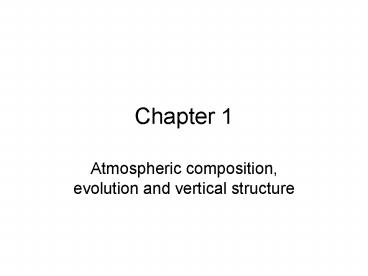Atmospheric composition, evolution and vertical structure - PowerPoint PPT Presentation
1 / 29
Title:
Atmospheric composition, evolution and vertical structure
Description:
2- moon has no atmosphere (weak gravity) 3- sun is essentially H and He ... Payne Stewart crash -1999. 99% of the air is below 30 km, radius of earth is ... – PowerPoint PPT presentation
Number of Views:65
Avg rating:3.0/5.0
Title: Atmospheric composition, evolution and vertical structure
1
Chapter 1
- Atmospheric composition, evolution and vertical
structure
2
- What elements and compounds are in the
atmosphere? - How did these constituents get there?
- What variables do we use to describe the weather?
3
- Gases, liquids and solids exist
- 1- abundant gases N2 , O2
- 2- trace gases very small amounts but crucial
for energy transfer and for life - H2O
- CO2
- O3
- CH4
- N2O, NO2, SO2
- hydrocarbons, chloroflurocarbons
4
(No Transcript)
5
- 3- aerosols liquids and solids
- examples rain, snow, dust, smoke,
- volcanic ejecta
- The big, counter-intuitive surprise is that the
- most abundant gas, N2 does not affect
- conditions on the planet like several of the
- trace gases
6
(No Transcript)
7
(No Transcript)
8
(No Transcript)
9
(No Transcript)
10
(No Transcript)
11
(No Transcript)
12
(No Transcript)
13
(No Transcript)
14
- How did we end up with these gases?
- Key factors include
- gravitation f(mass of the earth)
- mean speed of a gas f(molecular weight)
- temperature f(distance to the sun, suns T)
- radiation f( suns T)
- rise of life forms
15
- Big bang!? initially copious amounts of H
- and He? rapid escape of these ? volcanic
- outgassing provides H2O (85), CO2 , N2,
- and SO2? uv radiation causes
- disassociation of H2O resulting in O2?
- cooling of atmosphere causes clouds and
- rain ? oceans develop? life forms,
- photosynthesis converts CO2 to O2? CO2
- trapped in sediments? inert N2 and O2
- dominate atmosphere
16
- photosynthesis
- 6CO2 6H2O C6H12O6 6O2
- Evidence for the evolutionary scenario
- 1- present day volcanoes yield H2O and CO2
- 2- moon has no atmosphere (weak gravity)
- 3- sun is essentially H and He
- 4- lots of CO2 in sediments
17
- The composition of the atmosphere, save for
- one gas, is remarkably steady or very slow
- to change, so how do we describe the
- weather?
- Candidate variables are?
- 1- density mass/volume
- 2- pressure P F/A force acting on an area
- 3- temperature
- 4- winds
- 5- moisture (water vapor does vary)
- 6- pollutants
- 7-visibility
18
- Density mass per unit volume
- For air at sea-level, ? 1.2 kg per m3
- 2.65 lbs
- for water, ? 1000 kg per m3
- Pressure force per unit area
- weight of the air column above
- lbs per sq. inch, inches of mercury, but
- millibars is easiest
- 1 bar 1000 mb 105 N /m2
19
(No Transcript)
20
(No Transcript)
21
(No Transcript)
22
Payne Stewart crash -1999
23
- 99 of the air is below 30 km, radius of earth is
- 6400 km .atmosphere is 0.5
24
(No Transcript)
25
Summary CH1
- air is mainly N2 (78) and O2 (21), but
- trace gases (H2O, CO2, O3) play major role
- in the radiation budget (greenhouse gases)
- H2O is the only constituent that changes
- phase naturally, huge amounts of energy
- are absorbed or released as it goes from
- gas to liquid to ice
26
- Aerosols solids or liquids in the air, dust
- particles alter radiation and play a major role
- in droplet formation and growth
- ?, P, water vapor all decrease rapidly with
- height but T shows layers the troposphere
- is about 10 km thick, contains all weather,
- stratosphere is stable and radiation driven
- O3 absorbs uv radiation in stratosphere H2O and
- CO2 traps radiation from the earth global
- warming
27
(No Transcript)
28
(No Transcript)
29
(No Transcript)































